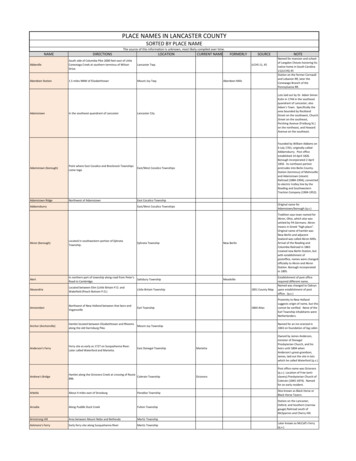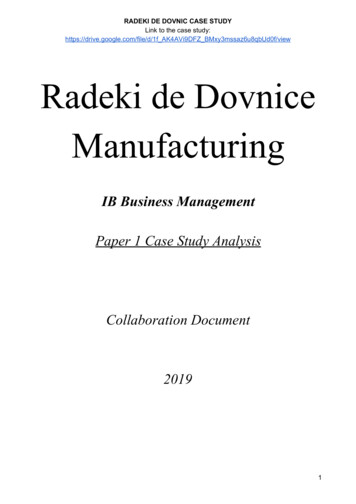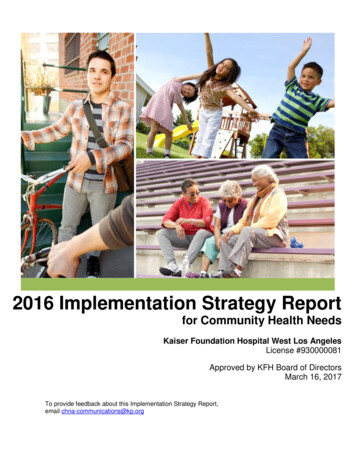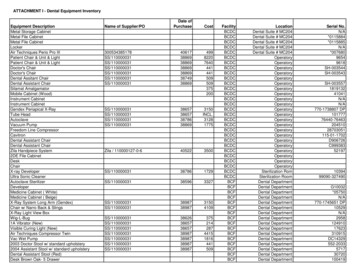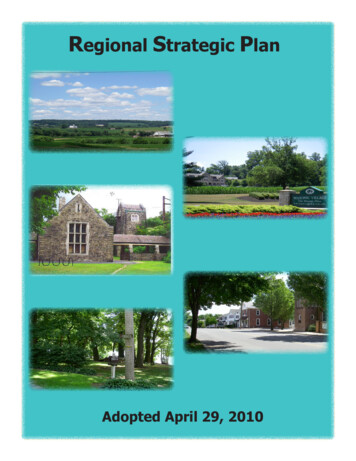
Transcription
Regional Strategic PlanAdopted April 29, 2010
Table of ContentsChapter 1- Introduction1Chapter 2- Implementation Actions12Chapter 3- Future Land Use Plan27Chapter 4- Transportation Plan77Chapter 5- Economic Development Plan92Chapter 6- Housing Plan109Chapter 7- Community Facilities Plan122Chapter 8- Natural & Cultural Resources Plan140Chapter 9- Agriculture Plan152Appendices:Background ProfilesDemographic ProfileExisting Land Use ProfileTransportation ProfileEconomic ProfileHousing ProfileCommunity Facilities ProfileNatural & Cultural Resources ProfileWater Resources Profile158Municipalities’ Objectives & Strategies242Implementation Actions Funding Sources Information259Community Survey Executive Summary276Municipalities’ Implementation Memorandum of Understanding280Strategic Plan Communication Plan284
Chapter 1 - IntroductionOverviewIntroductionThe communities of Elizabethtown Borough and Conoy, Mount Joy and WestDonegal Townships are a region unlike any other. While physically locatedImplementationwithin the boundary of Lancaster County, this region has carefully built anidentity that both connects it to and sets it apart from the two metro areas –Land UseLancaster and Harrisburg – that are its closest geographic neighbors. Thosewho live or work here know the region’s long enjoyed independence andstrength is a function of its people, economy and institutions.While other regions within Lancaster County – and across the CommonwealthTransportationEconomicDevelopmentof Pennsylvania – were just starting to learn about the upside ofintergovernmental cooperation, these communities were already reapingHousingthe benefits. Regional initiatives to improve water and sanitary sewer utilityinfrastructure, increase public safety and emergency services, and enhancequality of life through community and economic development are just someof the examples of the meaningful collaborations underway here. They havelearned through trial and error that working together will be the key to theCommunityFacilitiesNatural & CultrualResourcesregion’s success and sustainability. Through the creation of the RegionalStrategic Plan, which will serve as Elizabethtown Borough’s and Conoy,AgriculturalMount Joy, and West Donegal Townships’ regional comprehensive plan,the municipalities further demonstrate a clear understanding that criticallyimportant service delivery, environmental, economic, utility and transportationsystems are regional by nature and their proper planning, development, andmanagement will only improve with a regional perspective.1Appendix
Regional SettingConoy Township, Elizabethtown Borough, Mount Joy Township and WestDonegal Township are located in the Northwestern portion of LancasterCounty. The planning region is surrounded by York County to the west, andDauphin and Lebanon Counties to the north. East Donegal Township andMount Joy Borough are located to the south of the planning region andRapho Township is located to the east of the planning region. There areseveral major roadways that traverse the planning region including Routes283, 441, 743 and 230. Aside from these major roadways the planningregion contains a rail line that connects the region to urban centers suchas Lancaster City, Philadelphia and New York City.The planning region also contains several major waterways including theSusquehanna River, Conoy Creek, Conewago Creek, Donegal Creek, SnitzCreek and Little Chickies Creek. Both Conewago Creek and Conoy Creekwere identified in the Lancaster County Conservancy’s 2004 Long RangePlan as being areas of importance for natural resource protection.The majority of the region is serviced by Elizabethtown Area School Districtwith a very small portion of the region serviced by Donegal School District.Several private schools also offer service to the region including KraybillMennonite School, Mt. Calvary Christian School and Saint Peters ParochialSchool.The region also possesses several destination points that attract not onlyresidents of the planning region but many from outside the region. Suchunique destination points include Elizabethtown College, Masonic Village,2
Elizabethtown Fairgrounds, Pennsylvania Highlands, and the SusquehannaRiver.Strategic Plan PurposeThe Pennsylvania Municipalities Planning Code (MPC) calls for municipalities inthe Commonwealth to prepare or update comprehensive plans every ten (10)years. Such plans are intended to identify issues facing communities and to layout those steps that are to be taken to address them and shape a community’sdesired future.The MPC also provides for multiple municipalities to plan together in recognitionthat land uses and their impacts, and community life and its issues transcendmunicipal boundaries. Given the region’s tradition of collaboration among itsmunicipalities, the four municipalities determined that a regional plan wasappropriate.Further, as noted above, the region stands somewhat on its own betweenthe larger metropolitan areas of Harrisburg and Lancaster. This and previousplanning efforts have also identified strong potential for the region to growand prosper in the future. The region’s municipalities have demonstrated acapacity to take charge of their future and carry out the projects, programs, andinitiatives to move their communities and the region forward. Conoy Township,Elizabethtown Borough, Mount Joy Township, and West Donegal Township areeager to take the next steps in pursuit of their future and have prepared thisStrategic Plan to be used as a tool with that goal in mind.3
Strategic Plan FormatThis plan document is formatted to be strategic in nature and focuseson identifying major issues that affect the region and identifying priorityactions to address those issues. The Strategic Plan is organized into nine(9) chapters: Introduction, Implementation Actions, Future Land Use,Transportation, Economic Development, Housing, Community Facilities,Natural and Cultural Resources, and Agriculture. Chapters 4 through 9follow the format below: Overview - existing conditions, local/regional trends, keychallenges facing the municipalities of the region including strategicissues assessment for each chapter; Goal - an overarching goal is identified for each chapter; Ongoing Strategic Regional Priorities - these will be those initiativesfelt to be urgent for the region to pursue and in progress. Detailswill include the specific actions to be taken to address identifiedissues and achieve the stated goal, who will be responsible forthe actions, target dates for completion, sources of funding tosupport the actions, and identification of potential partners andstakeholders to work with; Regional Priorities To Be Pursued – those initiatives deemed tobe important to address identified issues and achieve the statedgoal, and to be pursued following adoption of the Strategic Planby the region’s four municipalities.4
An Appendix of background information follows these plan chapters. TheAppendix includes the Background Profiles that describe existing demographics:current housing; transportation; economic, natural and cultural resources;land use conditions; and community facilities in the region. Objectives andstrategies identified by each municipality for each plan chapter topic are listedalong with details of the funding sources identified for the Ongoing RegionalImplementation Priorities. Also found in the Appendix are the results of theCommunity Survey, the Implementation Memorandum of Understanding amongthe region’s municipalities, and the Regional Communication Plan used by themunicipalities to publicize the Strategic Plan and to collaborate with each otherin the Strategic Plan’s implementation.Strategic Plan ApproachA collaborative effort involving Conoy Township, Elizabethtown Borough, MountJoy Township and West Donegal Township officials, staff, Steering Committee,residents as well as Lancaster County Staff and a planning consultant was thefoundation for the Regional Strategic Plan of 2009. Residents and SteeringCommittee members identified issues early in the planning process by attendinga public meeting held at the Elizabethtown Area Middle School on May 22,2008. Residents were able to learn more about the Regional Plan at the August2008 Elizabethtown Fair at a booth manned by members of the SteeringCommittee. Residents also had the opportunity to rate community servicessufficiency and issues facing the region through two instruments: a writtenresidents survey conducted in August 2005 for Conoy Township residents; and,a written Community Survey conducted in the fall of 2008 by the Committeefor the broader region.5
Steering Committee members focused on selecting goals, objectives, andimplementing actions that would aim at addressing the issues that wereidentified throughout the planning process. The Steering Committee wasmade up of elected officials, planning commission members, municipalstaff, and residents of each of the four municipalities selected by theelected body of each municipality. The Steering Committee directedthe tone and content of the Plan, meeting on a monthly basis fromDecember 2007 to April 2009.Strategic Plan DirectionEarly on in the planning process, the Steering Committee identifiedquality of life as an important marker for determining the success of thisStrategic Plan. Moreover, over 90% of the respondents to the CommunitySurvey rated the quality of life in the Elizabethtown region as good orexcellent. As a result, the Steering Committee placed great emphasis onobjectives and implementation priorities that would address the varietyof quality of life components in the region.The following aspects of community life drew a great deal of attentionfrom the Committee: Traffic congestion (traffic congestion at peak times was identifiedas a “significant problem” by 47.6% of the Community Surveyrespondents). A complete list and map of traffic improvements tobe pursued by the region’s municipalities and to address trafficcongestion and safety are highlighted in the Transportation Planchapter based on recent transportation capital improvementsplanning in the region.6
Alternate modes of transportation/recreation (68% of Community Surveyrespondents supported the development of a regional trail system). TheSteering Committee developed a comprehensive conceptual regional trailsystem map as part of its Transportation work. Mass transit including trainservice to and from the region was also emphasized. Regional cooperation (85% of Community Survey respondents favoredintermunicipal cooperation in the provision of services in the region).The Committee recognized an ability to get much more done throughcollaboration. Past successes in regional police, wastewater treatment,water supply, recreation, and emergency response and this cooperativeplanning effort served as the foundation for additional collaborativepriorities in the Strategic Plan as well as the start of several collaborativeinitiatives during the planning process. Agricultural preservation/future land use/housing (72.2% of surveyrespondents felt that housing in the region is growing “a little too fast”or “much too fast”). The municipalities studied carefully the use ofTransferable Development Rights (TDRs) as a tool to facilitate housingdevelopment in the heart of Elizabethtown Borough and other designatedgrowth areas in the region and to facilitate agricultural lands preservationin outlying areas of the Townships.Regional Vision – drawing on these and other important aspects of communitylife identified through the Community Survey and the entire planning process,the region’s municipalities determined the following vision for the region’sfuture:7
“The region will pursue a course of action that enables it to be akey contributor to Lancaster County and the greater South CentralPennsylvania region while retaining its own unique identity. The region’smunicipalities will collaborate in those ways that best achieve efficiencyand adequacy of service while dealing with the regional challenges oftransportation, housing, economic development, land use, cultural andnatural resources, and community facilities. Land use will be coordinatedwith transportation and community facilities such that traffic movesefficiently, new development, redevelopment, and infill developmentis adequately serviced and takes place in designated growth areastargeted to meet the housing and economic development desires ofthe region, and such development occurs in harmony with the culturaland natural resources and character of the region. A variety of housingstyles and choices that provide affordably priced and accessible housingwill be provided for all who wish to live here. The services of suchinstitutions as Elizabethtown College, Donegal and Elizabethtown AreaSchool Districts, and Masonic Village will contribute significantly to theregion’s desirability. A region will evolve that due to new development,redevelopment, and infill development contains an economically vibrantand physically accessible Elizabethtown Borough at its core. At the sametime, the region’s three Townships will each emerge as their own uniquebalance of mixed use areas (suburban and village style), nodes ofcommerce (industrial parks and commercial centers), and characteristicagrarian lands (farms and historic/cultural resources).The chapters that follow in this Plan spotlight the implementation actionsthat are necessary to achieve this vision. Numerous new zoning provisions8
to be considered will help to coordinate future land use with community facilitiesand to create a variety of housing types that help to meet the needs of allincomes and age groups. Substantial transportation planning has already takenplace in the region such that a host of transportation improvements have beengiven high priority in this plan to achieve the region’s goal of moving trafficefficiently. Collaborative efforts such as a regional Transferable DevelopmentRights (TDR) program are spelled out in this plan that will help the region meetits agricultural preservation and economic development goals. People and theircommunities “plan to take action” and this plan is clearly focused on gettingthings done.AcknowledgementsConoy Township, Elizabethtown Borough, Mount Joy Township and WestDonegal Township wish to thank their residents and everyone who participatedin this planning effort for their interest and commitment to the future of theregion.Municipal Elected Officials:Conoy Township – Supervisors Chair Stephen L. Mohr, Supervisors Vice ChairClyde H. Pickel, Gina R. Mariani, John L. Shearer, Robert F. StricklandElizabethtown Borough – Mayor Robert Brain, Council President MeadeBierly, Council Vice President Phil Clark, Chuck Mummert, Jeff McCloud, C. DaleTreese, Tom Shaud9
Mount Joy Township – Supervisors Chair David W. Sweigart,Supervisors Vice Chair Gerald G. Cole, Ralph P. Miller, Don L. Bosserman,Charles G. Bailey, Jr.West Donegal Township – Supervisors Chair Nancy Garber, SupervisorsVice Chair Charlie Tupper, Roger Snyder, Clair Hilsher, Steve SpeersSteering Committee Members:Conoy Township – Kendra Mohr, Mike Skelly, Robert StricklandElizabethtown Borough – Derrick McDonald, Roni Ryan, C. DaleTreese, Peter WhippleMount Joy Township – Gerald Becker, Gerald G. Cole, Alyson Earl,Casey Kraus, Brandon WilliamsWest Donegal Township – Nancy Garber, Donald Kreider, WayneMiller, Roger Snyder, Nick ViscomeDonegal School District – Jim MorriseyElizabethtown Area School District – Amy Hodges Slamp, TroyPortserElizabethtown College – Caroline LalvaniMasonic Village – Patrick Sampsell10
Lancaster County Staff Members:Tara HitchensDean SeversonPlanning Consultant:RETTEW Associates11
Chapter 2 - ImplementationOverviewIntroductionThe key element to all planning that is done as part of a Strategic Plan isimplementation – taking action to carry out the goals and objectives set outImplementationin a Plan. Implementation actions are those steps to be taken as an answerto the question “what is the region going to do about the issues facing theLand Useregion described in the topical Plan Chapters 3 through 9. While the region’smunicipalities and partners such as the Elizabethtown Area School District,Elizabethtown College, and Masonic Village will lead implementation efforts,taking the steps to make the region the best place it can be is a responsibilityshared by nearly everyone who lives or works in the region.Below are set out regional implementation priorities that overlap Plan topicsTransportationEconomicDevelopmentHousingand will help the region reach multiple goals. Each Plan chapter also includesRegional Development Priorities that should be reviewed and evaluated whensetting priorities for future actions. Among the implementation priorities area first ever Regional Official Map of roadway improvements, trail system, andother community facilities; zoning ordinances modifications; and schedulingCommunityFacilitiesNatural & CulturalResourcesof roadway improvements.AgriculturalIt is important to note that significant implementing actions have beeninitiated by the region as part of the planning process, even prior to theadoption of the Comprehensive Plan. These include regional transportationplanning to prioritize funding for road and bridge improvements, adoptionof a communications plan which ensures effective regional communicationthroughout the implementation of the plan, and development of a regionaltrails network which will provide access to neighborhood and regionalrecreational opportunities.12Appendix
The first two actions that should be pursued in implementing therecommendations of the Comprehensive Plan subsequent to its adoption arethe establishment of the Regional Planning Authority and the developmentof an intermunicipal implementation agreement. These two actions willprovide the formal structure for prioritizing regional actions to implement theComprehensive Plan. The Regional Planning Authority will be responsible formonitoring progress made on these initiatives and reporting its findings to theregion’s elected officials and planning commissions on a regular basis.The following table identifies specific plan implementation tasks and who isresponsible for initiating and completing the project, as well as the projectedtime frame for completion of the project. Finally, potential funding sources fortask completion are also included.Please note that each chapter is pulled out below, but many of the projectscross chapter boundaries and could be implemented as a means to meeting agoal within another chapter.The projects below are color coded based on the following:Yellow – all four municipalitiesGreen – Elizabethtown BoroughOrange – Mount Joy TownshipPink – the three TownshipsBlue – West Donegal Township13
Regional Plan-The following are implementation efforts that will be required in order to move forward this regional planning documentand establish a regional approach to implementation.PlanElement/ObjectiveProject NameProject DetailsResponsible Reasoning forPartyProjectTarget Completion ementEstablish the roles,responsibilities, andlogistics of jointlyimplementing thisregional planAll themunicipalitieswithin theRegionPrioritize regionalimplementationactionsand reviewdevelopments ofregional impactEstablish aframework toimplement theIntermunicipalImplementationAgreement andprioritize actions01/2010To be theresponsibility ofeach municipalityEstablish by 06/2010,then on-goingTo be theresponsibility ofeach municipalityCoordinatemunicipal actionsacross the regionand inform eachmunicipality ofstatus of ongoingprojectsOn-goingNo overall fundingsource necessary,municipalitiesmust be willingto allow staff toattend meetingsand meeting spacewithin one of themunicipalities isnecessaryRegional Planning Constitute a regionalAgencyplanning anddevelopment entityChapter 5, Pageto provide advocacy,99planning andimplementation capacity,technical assistanceand financial resourcestoward the completion ofsignificant projects withinthis plan and that comeup as the planning timeframe moves forward forthe regionRegionalMunicipal managers,Communicationtransportation groupMeetingsand elected officialsjoint meetings areChapter 3, Pages held regularly to64-65maintain priorities andcommunicate direction toimplementing entitiesAll themunicipalitieswithin theRegionAll themunicipalitieswithin theRegion14
Transportation Plan- One of the central elements of this Comprehensive Plan is to provide for a regional vision and regional solutions to transportationissues. As stated above, the four participating municipalities have already initiated efforts to regionally plan for transportation improvements. Thefollowing recommendations comprehensively address a full range of transportation modes- auto, rail, bus, and non-motorized options.PlanElement/ObjectiveProject NameProject DetailsResponsiblePartyReasoning al OfficialMapExhibit approximateroad improvementsand desired communityfacilities improvementsAll of the Region’smunicipalitiesCoordinateimprovementsthat have aregional impact06/2010, withamendments asneededLUPTAPLMRDPConstruct improvementsincluding intersectionturn lanes andrealignments, roadextensions, roadwaywidening, and new roadconnections per theRegional TransportationImprovements Map inChapter 5 and the 2006Regional TransportationStudyPrepare regional trailsystem plan and mapand construct prioritysegments (THIS COULDBE PART OF THEREGIONAL OFFICIALMAP)One, some or allof the Region’smunicipalities,PennDOT,Lancaster CountyTransportationAuthority, localbusinesses, privateproperty ownersCoordinatetransportationimprovementsso that fundingis directed tothe highestpriority projectsthroughout theregion2010-2020TIP and LRTPCMAQMTGOne, some or all of theRegion’s municipalities,PennDOT, LancasterCounty TransportationAuthority, LancasterCounty PlanningCommission, localbusinesses, privateproperty ownersIncreaseconnectivity andwalkability withinand betweenthe region’sneighborhoodsand communities2010-2020PA DCNRFHA TEUEFChapter 3, Page66Plan andTraffic CongestionConstructRelief ProjectsRoadImprovements Chapter 4, Page85Plan andConstruct aPedestrian andBicycling Chapter 4, Page8615
PlanElement/ObjectiveProject NameProject DetailsResponsiblePartyElizabethtownTrain Station andSatellite ParkingInitiativeRenovate and expandthe Elizabethtown trainstation including access,parking, lighting, andsafety upgrading andrestoration of the existingstation, surroundingsite improvements, andsatellite parking forregional commutersIdentify and developappropriate locationsfor formal park and ridelocations, most likely inclose proximity to Route283Plan andChapter 5, PageImplement100TransitImprovementsEstablish formalpark and ridefacilitiesChapter 4, Page89Reasoning ethtownEnhance theBorough will lead this Elizabethtowneffortstation as oneof the fastestgrowing stopson the KeystoneCorridor12/2012MTGUEFLMRDPTIP and LRTPFHA TEMount Joy Townshipmay take the leadon this effort, butthe Region shouldconsider other siteswhen necessary12/2011MTGUEFPrivate PartnersProvide for safeand controlledareas to facilitatepark and rideservicesFuture Land Use Plan - The Region possesses a diverse and vibrant mix of land uses, including extremely productive agricultural land,centers for commercial, industrial and institutional uses, historic villages, and a borough which serves as the hub for the region. The goalof the future land use plan is to maintain this mix of land uses and to plan for future growth in a phased and coordinated manner. Theoverriding intent of the Future Land Use Plan is to carefully determine what the forecasted growth needs of the region are and phase inthis development over time. Future growth in the Region must be planned in concert with the services and facilities needed to supportthis growth.The following recommended implementing actions, including guidance on rezoning parcels of land, development of a regional officialmap, development of TDR programs, plans for Elizabethtown’s redevelopment and others, will all lead to coordinated and balancedgrowth throughout the Region.16
Plan Element/ObjectiveProject NameProject DetailsResponsiblePartyReasoning forProjectThe three Townshipswithin the Region.To implement thefuture land userecommendationsidentified in thePlanProvide formal guidelinesto evaluate landownerrequests to add land tothe DGA and rezone landfor future developmentAll municipalitieswithin the Region.To assistmunicipal PlanningCommissions andelected officialsin evaluatingproposalsModify zoning ordinanceterminology andprovisions to be consistentamong the region’smunicipalitiesAll municipalitieswithin the Regionwith assistance fromLancaster CountyPlanning CommissionTo assistlandowners,developers, andothers in reviewingzoning ordinances2012Identify specific sendingand receiving parcels andrevise the standards fortransferMount Joy Townshipwill lead this effortTo direct growthto DGA’s and allowfarmers to selldevelopment rights2010Adopt rezoningrecommendationsidentified in thisplan.Plan for andImplement FutureLand Use PlanRecommendationsChapter 3, Pages60-62, 67, 72-74Incorporate theguidelines forconsiderationof additions tothe DGA as anamendmentto the zoningordinances of allthe municipalities.Develop a zoninglexicon for theregionRevise the MountJoy Township TDRProgram17TargetFundingCompletion SourcesDate
Plan Element/ObjectiveProject NameProject DetailsInstitute a Regional Establish a regionalTDR ProgramTransferable DevelopmentRights (TDR) programChapter 8, Page 54 including TDR valuation,identification of TDRsending and receivingareas, zoning ordinancerevisions, the mechanicsof TDR purchase, saleand registration and aneducational component forsending area landownersContinue toImplement theRecommendationsof the Master Planfor DowntownElizabethtownChapter 5, Page104ImplementCenter SquareRenovationsand High &Market StreetsStreetscapingChapter 5, Page101ResponsiblePartyReasoning forProjectTargetFundingCompletion SourcesDateMunicipal appointedand elected officialswith support fromLancaster CountyPlanning CommissionTo direct growthto DGA’s and allowfarmers to selldevelopment rights2013See Master Planfor complete list ofrecommendationsElizabethtownRevitalize andBorough will lead this enhance theeffortBorough’sdowntown whilepreserving keyhistoric andenvironmentalfeaturesComplete renovations toElizabethtownSee aboveCenter Square, downtown Borough will lead thisstreetscape improvements effort.on High Street andMarket Street, as wellas pedestrian and nonmotorized connectionsfrom the downtown to thegreater region18Ongoing2010-2012
Plan Element/ObjectiveProject NameProject DetailsResponsiblePartyReasoning forProjectTargetFundingCompletion SourcesDatePlan for andimplementthe Route 743InterchangeDistrictDevelopmentEncourage, promote, andinvest in the creation ofcommercial and/or mixeduse development withinthe I-1 Zone at the Route743 interchangeMount Joy Townshipwill lead this effortProvide forfuture economicdevelopment inorder to expandtax base andemployment in anarea planned forfuture growth2010-2015Promote, attract, andinvest in industrialdevelopment within theI-2 zone a the CloverleafRoad interchangeMount Joy Townshipwill lead this effortProvide forfuture economicdevelopment inorder to expandtax base andemployment in anarea planned forfuture growth2010-2015Chapter 5, Page102Plan for andimplement theCloverleaf RoadInterchangeDistrictDevelopmentChapter 5, Page103Economic Development Plan- The region in recent decades has experienced a tremendous growth in residential development.It is imperative that this residential growth be balanced by a strong regional economy that can provide the tax base and employmentneeded by the region. Future economic development efforts will recognize both the existing commercial and industrial base in the region,such as Mars, Greiner, the Conewago Industrial Park and the Lancaster County Solid Waste Management facility, but also look for newopportunities such as a proposed location for a professional office park. The following recommendations are intended to maintain andstrengthen the balance between rural and urban economic activities.19
Plan Element/ObjectivePlan for a vibrantand sustainableeconomyProject NameProject DetailsResponsiblePartyReasoning forProjectTargetFundingCompletion SourcesDateDevelop aProfessionalOffice Park/LightIndustrial zoningdistrict in WestDonegal TownshipChapter 5, Page105Create an Office Park/Light Industrial zoningdistrict containingapproximately 160 acresease of Maytown Road/PA Route 743West DonegalTownship will leadthis effortTo provide for aneconomic use, notgenerally providedfor currently in theregion, that wouldprovide tax baseand employmentgrowth2010LUPTAPHousing Plan- The following recommendations are intended to maintain a wide range of housing opportunities in the region and providefor residential development in a balanced manner, consistent with future forecasted demand. As the region’s citizen’s age and householdstatus changes over time, it is important that there are a variety of housing options available.Plan Element/ObjectiveMaintain andExpand RegionalHousing OptionsProject NameProject DetailsImplement zoningand subdivisionordinanceamendments toprovide for a widerrange of regionalhousing optionsModify municipal zoningAll municipalitiesordinance provisions towithin the Regionaddress increasing desire formore modest housing in acompact setting convenientto the everyday needs ofresidents, and promote avariety of home types withinany one neighborhood with afocus on ease of usability forvarious ages and capabilitiesChapter 6, Page114ResponsibleParty20Reasoning forProjectTargetFundingCompletion SourcesDateTo
Susquehanna River, Conoy Creek, Conewago Creek, Donegal Creek, Snitz Creek and Little Chickies Creek. Both Conewago Creek and Conoy Creek were identified in the Lancaster County Conservancy's 2004 Long Range Plan as being areas of importance for natural resource protection.


